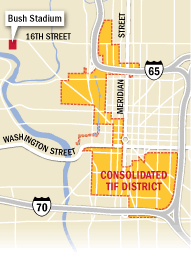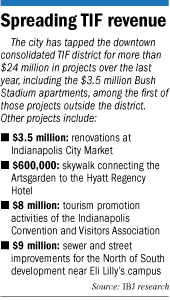Subscriber Benefit
As a subscriber you can listen to articles at work, in the car, or while you work out. Subscribe NowThe city plans to tap a sometimes-controversial taxing district downtown to help pay for the Bush Stadium renovation—one of just a handful of times it’s used money generated within that district to pay for something outside it.
The move has rekindled concern among some elected officials and taxing experts that the Mayor’s Office is using the massive district to fund whatever special city needs crop up instead of collecting less revenue or more quickly paying down the more than half-billion dollars in bonds issued to help finance downtown projects.
 The city this month said it will funnel $3.5 million in revenue from its downtown tax increment financing, or TIF, district to provide the majority of the $5 million in public support for the $23 million Bush Stadium project.
The city this month said it will funnel $3.5 million in revenue from its downtown tax increment financing, or TIF, district to provide the majority of the $5 million in public support for the $23 million Bush Stadium project.
That money, collected from property taxes on new development within the downtown district, will go toward developer John Watson’s plan to turn the stadium near 16th and Harding streets—about a mile outside the downtown TIF district’s nearest boundary—into an apartment complex.
The downtown TIF revenue’s primary purpose is to pay down debt on big projects within the boundaries of the district. But state law also allows it to be used for smaller economic-development projects within the district or outside it, such as Bush Stadium.
 But the practice of using TIF revenue outside district boundaries raises concern among academics, TIF experts and some elected officials. They say it can set a precedent for using TIF dollars too liberally, and in the process channel tax money away from entities such as libraries and schools.
But the practice of using TIF revenue outside district boundaries raises concern among academics, TIF experts and some elected officials. They say it can set a precedent for using TIF dollars too liberally, and in the process channel tax money away from entities such as libraries and schools.
“It’s at the expense of other units of government,” said Fred L. Armstrong, who was instrumental in creating the original downtown TIF as city controller for two decades and now consults with Indy Go on financial matters. “You’ve got to take care of your current problems before you create new ones.”
City leaders, however, say the TIF was among the only funding sources available to subsidize the massive Bush Stadium renovation.
That project is designed to serve as a catalyst to make the area between IUPUI and West 16th Street a corridor for high-tech jobs.
“Unfortunately, funds aren’t that fungible. This is a pot of funds that can be used,” said Deron Kintner, director of the Indianapolis Local Public Improvement Bond Bank, which issues debt on behalf of the city. “Without the use of the downtown TIF, you probably don’t get to save Bush Stadium.”
Too much revenue?
The consolidated downtown TIF spans from Interstate 70 on the south to 19th Street—east of the Bush Stadium project—on the north. It was formed from several downtown taxing districts that were established in 1982.
The concept behind it is to capture additional tax revenue generated from new projects in the district to pay off debt stemming from infrastructure improvements and other government investment that helped spur those projects. TIF backers say many of the projects wouldn’t have occurred without government subsidies.
The downtown TIF’s $677 million in outstanding debt stems from subsidies for such projects as the J.W. Marriott hotel and the Simon Property Group Inc. headquarters.
In recent years, the TIF has generated $55 million per year, more than what’s needed to make payments on that debt. The city has $54 million in reserve, about 8 percent of the total debt.
That amount provides a cushion to help bondholders feel secure that debt payments can be made with room to spare. But the city also has tapped the funds to use for economic development projects, mostly within the district.
In the last year, the city has set aside $24 million for projects that include renovations at the Indianapolis City Market and infrastructure for the North of South development near Eli Lilly and Co.’s campus.
Past critics of such expenditures say earmarking TIF revenue for Bush Stadium has renewed their scrutiny.
When a district raises more than is needed, the city has the option of reducing the amount of revenue flowing into it by diminishing how much of the district’s assessed value is taxed as TIF-eligible. In some cases, the city also can use excess revenue to pay off bonds in the district early.
Both moves would help other local government units—such as schools, townships and libraries—by increasing the amount of assessed value included in the general tax base. That would lower tax rates or, in some cases, increase tax revenue.
Skeptics say using the money instead for additional projects—particularly outside the district—may unnecessarily add to the financial strain government units are under.
“When we consider the never-ending uses for the downtown TIF dollars, it kind of looks a little slush-fund-like,” said Brian Mahern, a City-County Council Democrat who has been a vocal critic of the city’s economic development policies.
“The concern here is, will money that is available be spent, as opposed to [asking], ‘Does that money need to be collected?’”
City leaders say they have taken steps to reduce the amount of revenue the district collects.
Reserves grew robustly in 2008, when revenue rose as new projects came online and refinancing helped debt obligations remain steady. The TIF continued to perform well in 2009 and 2010 as the city collected revenue to its full capacity.
For this year, though, the city decided to forgo collecting business personal property taxes for the district’s benefit, a move that reduced excess revenue from $28 million in 2010 to a projected $14 million this year.
Kintner said the city also will forgo those collections next year, keeping excess revenue collections at a projected $14 million in 2012.
He said eventually the city intends to further reduce the amount of revenue collected so more money can go back to the general tax base.
But first leaders want to increase the reserve from $54 million to $68 million, or roughly 10 percent, to give bondholders more confidence in a shaky municipal bond market.
Defining the benefit
Choosing to spend some of the reserves for projects such as Bush Stadium, however, moves the city away from that goal.
City officials counter that the Bush Stadium subsidy is a worthy investment, because it makes a project viable that will cause the downtown TIF to further prosper.
State statute allows municipalities to use TIF revenue outside a district’s boundaries if the expenditure benefits the district of origin.
City leaders argue the Bush Stadium project meets that requirement because it will spur renewal and economic development in the area, which will help attract jobs to the 16th Street corridor. And added jobs near downtown will benefit the downtown district, they say.
“These people are going to come downtown to shop, to eat, and as it becomes an employment hub, a lot of people will live downtown,” Kintner said.
Some TIF experts call that argument a stretch. Bruce Frankel, a professor of urban planning at Ball State University, said Indiana law allows flexibility in how the benefit for a district of origin is defined.
Municipalities, increasingly, have taken advantage of that to transfer TIF outside the district, Frankel said.
But the intent of allowing TIF funds to be used outside districts, he said, is to fund initiatives that have logical synergies with specific projects in the district.
For example, a commercial development that didn’t fit in a TIF district of origin could be built outside the district to provide retail amenities to residents of an apartment complex within the district.
Indianapolis leaders don’t provide that kind of specificity in the Bush Stadium case, he said.
“Any project you can dream of probably has some general benefit to the downtown—or even the city—as a whole,” Frankel said. “The law was written for a purpose—it’s supposed to be targeted geographically.”
Allowing for such interpretation can open the door to overly broad use of the TIF funds.
But Kintner said that’s far from the city’s intent.
“We’re limited by statute in how we spend the downtown TIF,” he said. “All of our uses of the fund have been in accordance with the state statute.”
The Metropolitan Development Commission—appointed by the City-County Council, the mayor and county commissioners—ultimately will decide whether Bush Stadium is a proper use of the funds. It’s expected to take up the issue next month.•
Please enable JavaScript to view this content.
